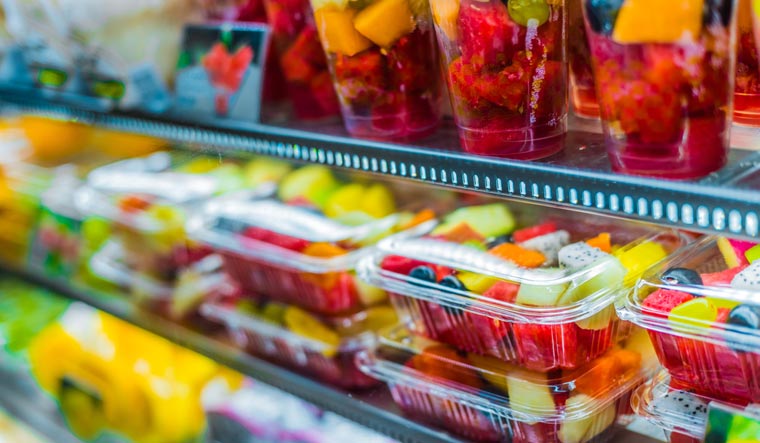Plastic Packaging Has An Evil Twin
Jun 16, 2022 | Pratirodh Bureau
The issue of food waste will not be solved in isolation from the issue of plastic packaging. Nor will the issue of plastic waste be solved without addressing food waste. The problems are entwined (Representational Image)
The problem of too much plastic packaging will not be solved without addressing its larger twin: food waste.
Just three countries — the United States, China and Brazil — are responsible for a staggering 44.6 per cent of all the world’s plastic packaging, the majority of it wrapped around food, according to a paper released last month.
But most of that packaging is torn off in other countries, making the US, China and Brazil packaging exporters. Twelve billion tonnes of plastic packaging will be clogging up landfill by 2050.
The flood of packaging demands resources, causes pollution and creates severe waste problems. There are global efforts to stem the tide. But along the way an important question seems to have been overlooked: why use packaging in the first place?
Food packaging protects the contents between production and consumption. If packaging is the environmental disaster story, protection of food is the success story. When food isn’t consumed because it wasn’t properly protected, all the resources that went into growing the food are lost.
The environmental problems connected to food are a magnitude larger than the ones packaging causes. The food humans consume is responsible for 21 to 37 percent of global climate change, is the major cause of species extinction, and slurps up about 70 per cent of global fresh water.
But one-third of all produced food is wasted. This waste accounts for 8 to 10 percent of total human greenhouse-gas emissions. Moreover, increasing food prices due to war and climate change have already hit millions of people. Less food waste can lower prices.
Because most food spoils, advanced food packaging allows more time and distance between production and consumption, reducing food waste and making modern societies possible.
Reducing food packaging without analysing the effects on food waste may create an environmental and social mess. Food and its packaging need to be considered as a unit.
But such analysis is not straightforward: environmental impact varies between food products. Take beef, for example. One study showed the climate impact of beef was 780 times higher than the impact of its packaging.
The same study showed the impact of a plastic water bottle was 17 times higher than the impact of the water. This means even elaborate beef packaging can be environmentally justified if it will reduce the waste of beef. Single-use water bottles, though, appear to be unjustifiable.
In analysing food waste and packaging as a unit, researchers also must know the most common reasons for the waste. While packaging can preserve food, it can also contribute to food waste if it doesn’t properly serve the needs of consumers.
Consumers most commonly waste food because it has gone bad or they think it has gone bad because the date on the packaging has passed.
While best before’ and use by’ dates are often perceived as interchangeable, in most countries ‘best before’ refers to food quality and ‘use by’ refers to food safety.
Consumers, particularly younger ones, are not confident about using their nose or taste to test the freshness of ‘expired’ food so they throw things away when their best-before dates have passed. Packaging could communicate the different functions of the dates in a better way to reduce food waste.
Packaging also has suggested serving sizes, but these may not be very reliable. A single serving size on different Australian rice brands varies from 60 grams to 90 grams.
Plenty of rice or pasta is thrown away because too much was cooked. Better serving instructions could save tonnes of rice and pasta from being wasted.
Then there is the issue of packaging sizes. A typical story for a chilled product is: the packaging is opened, the contents are partly used, and the remainder is returned to the fridge. After a while, the product is rediscovered with an unpleasant smell and thrown away.
A lot of packaging protects food very well until it is opened. Some food products are protected by a modified atmosphere inert gases that disappear as soon as the packaging is opened. Others are sensitive to humid air.
Most of the clever technologies embedded in packaging are gone the moment the packaging is opened. But smaller or compartmentalised packaging reduces the time the food is exposed, potentially reducing food waste.
In the store, the economic-minded customer may think larger packs give more value for money. The environmentally concerned customer may think there will be less packaging materials per food unit with larger packaging.
Both these things are true, but the economic and environmental cost of food waste is not included in the calculations. The price per unit is sometimes so much lower with the larger pack that consumers choose the larger one even though some will be wasted. Buy two, waste one free!
The issue of food waste will not be solved in isolation from the issue of plastic packaging. Nor will the issue of plastic waste be solved without addressing food waste. The problems are entwined. From production to consumption, they must be addressed together in efforts to live more sustainably.
(360info.org: By Fredrik Wikstrm, Heln Williams, Karlstad University)
